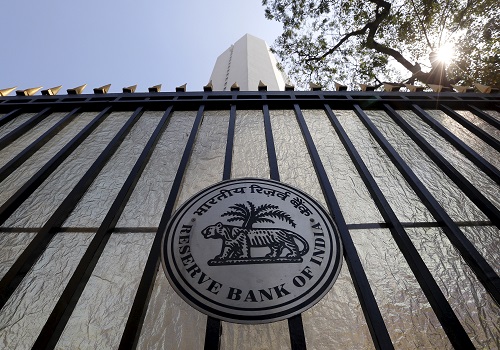Gold trading range for the day is 78555-79105 - Kedia Advisory

Follow us Now on Telegram ! Get daily 10 - 12 important updates on Business, Finance and Investment. Join our Telegram Channel
Gold
Gold prices rose by 0.56% to settle at 78,867, driven by a sharp decline in U.S. job growth, which shifted investor sentiment toward safe-haven assets. Nonfarm payrolls increased by only 12,000 in October, falling well below the expected 113,000, though hurricanes and strikes during the period influenced this figure. Revisions to prior payrolls further indicated a softening labor market, raising the likelihood of extended Federal Reserve rate cuts next year. The U.S. GDP grew at an annualized 2.8% in Q3, below the forecasted 3%, yet strong consumer spending continued to signal resilience amid high interest rates. The ADP report’s surge in private-sector job growth reinforced views of a robust labor market, potentially allowing the Fed to delay urgent rate cuts. In India, physical gold dealers offered discounts of up to $8 an ounce over official domestic prices due to reduced demand amid record-high prices, a shift from last week's $3 premium. Chinese dealers narrowed discounts to $3-$14 below international spot prices from $15-$31 last week. In Hong Kong, gold traded between a $2 discount and a $1.20 premium, while in Singapore, it ranged from a $0.80 discount to a $2.20 premium. The World Gold Council (WGC) reported stable global gold demand at 1,176.5 metric tons year-on-year in Q3, with investment flows offsetting reduced jewelry consumption. Including OTC trading, total demand rose by 5% to a record 1,313 tons. Technically, gold is under fresh buying, as evidenced by a 0.66% increase in open interest to 13,567 contracts, with prices up by 437 rupees. Support is at 78,710, with potential tests at 78,555, while resistance is seen at 78,985, and a break above could target 79,105.
Trading Ideas:
* Gold trading range for the day is 78555-79105.
* Gold gains amid U.S. job growth slowed sharply in October
* Nonfarm payrolls rose by 12,000 in October, well below market expectations of 113,000.
* India's gold imports, rose by 21.78 percent to $27 billion during April-September this fiscal.
Silver
Silver gained 0.9% to close at 95,483, propelled by a labor market report showing significant slowing in job growth, reigniting hopes for accelerated interest rate cuts by the Federal Reserve. The U.S. economy added only 12,000 jobs in October, far below the market forecast of 113,000, with September's numbers revised down to 223,000. Job growth was hindered by Hurricanes Helene and Milton and strikes at Boeing. While a 25 basis point rate cut is expected in the coming week, persistently weak data may push the Fed to consider more aggressive cuts. Meanwhile, U.S. inflation data exceeded expectations, and jobless claims fell, indicating continued labor market strength. This dynamic pushed 10-year U.S. Treasury yields to their highest levels since early July, reflecting increased investor caution and impacting precious metals as the outlook for monetary policy remains tight. Market focus is on upcoming data, which could influence silver’s price trajectory. India's silver imports are set to almost double this year, driven by rising demand from solar panel and electronics manufacturers and investor interest due to better expected returns compared to gold. The country imported 3,625 metric tons last year, and data from the trade ministry shows imports in the first half of 2024 surged to 4,554 tons from 560 tons a year earlier. This surge reflects industrial buyers stockpiling silver amid depleted inventories in 2023 to hedge against price increases. Technically, the market is experiencing short covering with a 0.5% decline in open interest to 23,471, while prices climbed by 852 rupees. Support for silver is at 95,010, with a potential dip to 94,530. Resistance is at 95,835, and a breakout could see prices testing 96,180.
Trading Ideas:
* Silver trading range for the day is 94530-96180.
* Silver gains after as US jobs growth slowed substantially brining again the possibility of speed up in interest rate cuts.
* The US economy added only 12K jobs in October, compared to market expectations of 113K
* US inflation data exceeded expectations and jobless claims dropped, pointing to continued labor market strength.
Crude oil
Crude oil prices increased by 2.83% to close at 5,988, supported by stronger-than-expected U.S. fuel demand and reports that OPEC+ may delay a planned output hike. U.S. gasoline inventories dropped to a two-year low in the week ending October 25, according to the Energy Information Administration (EIA), exceeding expectations with a 2.7 million-barrel decline against a forecasted 0.6 million increase. Crude inventories also surprised markets with a drawdown of 0.515 million barrels, contrasting with expectations of a 2.3 million-barrel build. This was partly due to reduced import levels. Meanwhile, Cushing, Oklahoma crude stocks rose by 0.681 million barrels, reversing a previous decline. Further support came as the U.S. Department of Energy announced plans to purchase up to 3 million barrels for the Strategic Petroleum Reserve, which has already seen 55 million barrels repurchased at an average price of $76 per barrel. Saudi Arabia reiterated its commitment to maintaining a crude production capacity of 12.3 million barrels per day, reinforcing market stability. The EIA’s Short-Term Energy Outlook reported a downward revision for global oil demand growth due to weaker economic conditions in China and North America. World oil demand is now expected to grow by 1.2 million barrels per day to 104.3 million bpd in 2025, 300,000 bpd lower than prior estimates. U.S. oil production forecasts were also adjusted to 13.22 million bpd for 2024, slightly down from previous projections. Technically, crude oil is under fresh buying interest, as open interest increased by 1.75% to 14,080 contracts while prices rose by 165 rupees. Support is seen at 5,918, with potential tests at 5,849, and resistance is expected at 6,028, with a move above targeting 6,069.
Trading Ideas:
* Crudeoil trading range for the day is 5849-6069.
* Crude oil gained on stronger than expected U.S. fuel demand
* Producer group OPEC+ could delay a planned output increase.
* U.S. gasoline stockpiles fell more than expected to a two-year low, EIA said.
Natural gas
Natural gas prices declined by -1.31% to settle at 226.5, driven by expectations of a larger-than-usual storage build and forecasts for continued mild weather through mid-November. This milder weather is anticipated to curb heating demand, allowing utilities to add more gas into storage. LSEG reported average gas output in the Lower 48 U.S. states at 101.7 billion cubic feet per day (bcfd) in October, slightly down from 101.8 bcfd in September and below the record 105.5 bcfd in December 2023. Recent daily output fell by approximately 2.3 bcfd to a two-week low of 101.0 bcfd. Meteorologists predict warmer-than-normal weather in the Lower 48 states through mid-November, which, although cooler than October, will still suppress gas demand. LSEG forecasts that average gas demand, including exports, will rise from 99.5 bcfd this week to 100.9 bcfd next week. The EIA's Short Term Energy Outlook indicates a projected decline in U.S. natural gas production from a record 103.8 bcfd in 2023 to 103.5 bcfd in 2024, with demand reaching a record 90.1 bcfd in 2024. The EIA also forecasts LNG exports to increase to 12.1 bcfd in 2024 and 13.8 bcfd in 2025. U.S. utilities added 78 billion cubic feet of natural gas to storage for the week ending October 25, 2024, aligning closely with market expectations. This raised storage levels to 2.8% above last year and 4.8% above the five-year average. Technically, the market saw long liquidation with a -2.65% drop in open interest, settling at 21,708 contracts while prices fell by 3 rupees. Natural gas finds support at 224.2, with further downside potential to 221.9. Resistance is expected at 228.8, and a breakout above could see prices reaching 231.1.
Trading Ideas:
* Naturalgas trading range for the day is 221.9-231.1.
* Natural gas fell due to an expected bigger-than-usual storage build and forecasts for mild weather to continue through mid-November.
* U.S. EIA said utilities added 78 bcf of gas into storage during the week ended Oct. 25.
* Average gas output in the Lower 48 U.S. states has eased to 101.7 bcfd so far in October, down from 101.8 bcfd in September.
Copper
Copper prices increased by 0.85% to close at 847.8, supported by positive manufacturing data from China, which showed an expansion in October for the first time in six months. This turnaround in manufacturing activity, bolstered by improved export orders, indicates that recent stimulus measures are beginning to revitalize the economy. The market remains cautious, however, as traders await potential new measures from China's top legislative body, set to convene from November 4-8. Additionally, concerns surrounding the U.S. presidential election have kept some participants on the sidelines. On the supply side, Chile's state-owned Codelco reported a 4.9% year-on-year decline in its copper output, totaling 918,000 metric tons from January to September. The global refined copper market displayed a surplus of 54,000 metric tons in August, down from a 73,000 metric tons surplus in July, according to the International Copper Study Group (ICSG). For the first eight months of the year, the surplus reached 535,000 metric tons, compared to 75,000 metric tons in the same period last year. World refined copper output in August was 2.32 million metric tons, while consumption was 2.27 million metric tons. When adjusted for inventory changes in Chinese bonded warehouses, the August surplus stood at 42,000 metric tons, down from 63,000 metric tons in July. China's imports of unwrought copper increased to 479,000 metric tons in September, a 15.4% rise from August, reflecting stronger seasonal demand. Technically, copper is experiencing short covering, evidenced by a 1.73% drop in open interest to 7,155 contracts as prices rose by 7.15 rupees. Current support is at 843.4, with further tests at 838.9, while resistance is anticipated at 850.7, with potential moves toward 853.5.
Trading Ideas:
* Copper trading range for the day is 838.9-853.5.
* Copper gains as China's October manufacturing activity swung back to expansion for the first time in six months
* Copper output from Chile's Codelco down nearly 5% in January – September
* China's top legislative body will meet from Nov. 4-8, where market participants hope Beijing will announce more measures for its economy.
Zinc
Zinc prices rose by 1.19% to settle at 285.95 as raw material shortages pressured smelters to cut back on refined metal production. This follows a recent increase in stocks at LME-registered warehouses, which slightly alleviated immediate concerns over supply tightness. The deliveries contributed to a narrowing premium for the cash contract over the three-month zinc contract, which fell to $18 per ton from last week’s peak of over $58 per ton. However, uncertainty persists as China's industrial profits in September marked the sharpest monthly decline this year, driven by weak demand and falling producer prices. Compounding the supply concerns is the situation with Russia’s zinc producer Ozernoye, facing production challenges due to sanctions impacting equipment procurement. This puts at risk their forecasted output of 320,000 metric tons for 2025, representing approximately 2.5% of the global mined zinc supply, according to the ILZSG. The ILZSG's projections included robust growth of 8.9% in new mining zinc supply outside China in 2025, highlighting the potential impact of any disruptions at Ozernoye. The global zinc market deficit expanded to 66,300 metric tons in August, up from 51,000 tons in July, as reported by the ILZSG. China's September refined zinc production rose over 2% month-on-month but declined by more than 8% year-on-year, exceeding expectations. October production is forecasted to grow modestly, concentrated in Inner Mongolia, Shaanxi, and Hunan, offset by reductions in Gansu due to maintenance. Technically, the market is undergoing short covering, with a -7.92% decrease in open interest to 2,651 as prices increased by 3.35 rupees. Zinc finds support at 284.4, with a potential test at 282.7. Resistance is seen at 287.3, with a move above possibly pushing prices to 288.5.
Trading Ideas:
* Zinc trading range for the day is 282.7-288.5.
* Zinc gains as a raw materials squeeze forces smelters to reduce production of refined metal.
* Chinese data suggesting poor demand prospects added to disappointment with economic stimulus measures
* China’s industrial profits plunged in September, registering the steepest monthly decline of the year, owing to factors including weak demand
Aluminium
Aluminium prices increased by 0.96% to close at 241.55, supported by strong manufacturing activity data from China, the leading consumer of the metal. A private survey indicated that China’s factory activity expanded in October, bolstered by a series of stimulus measures aimed at spurring economic growth. Additional support came from alumina shortages that triggered systematic buying by funds. Supply concerns were heightened as Guinea, a major bauxite exporter, suspended shipments from Guinea Alumina Corporation (GAC) around two weeks ago. LME data revealed significant futures positions, with over 40% of open interest for December buying and 30-39% for January selling. Goldman Sachs revised its 2025 aluminium price forecast upwards to $2,700 per ton from $2,540, reflecting anticipated stronger demand in China following the economic stimulus. The IMF reduced its 2025 global growth forecast to 3.2%, citing potential risks like geopolitical conflicts and trade protectionism but commended central banks for managing inflation effectively. Global primary aluminium production rose 1.3% year-on-year to 6.007 million tonnes in September, according to the International Aluminium Institute (IAI). In China, September’s aluminium output increased 1.2% year-on-year to 3.65 million metric tons, supported by firm demand and profitable margins, with daily output averaging 121,667 tons. For the first nine months of 2024, China’s aluminium production rose 4.6% to 32.56 million tons. Technically, the market is experiencing fresh buying, indicated by a 1.3% rise in open interest to 3,584 contracts as prices climbed 2.3 rupees. Support is at 240.5, with potential tests at 239.5, while resistance is anticipated at 242.6, with a move above potentially reaching 243.7.
Trading Ideas:
* Aluminium trading range for the day is 239.5-243.7.
* Aluminium gains as strong manufacturing activity data bolstered demand expectations in China
* Support also seen amid news of alumina shortages triggered systematic buying from funds.
* Manufacturing activity in China expanded in October for the first time in six months
Cottoncandy
Cottoncandy prices rose by 0.45% to settle at 55,900, supported by a downward revision in India’s cotton production forecast for the 2024-25 season. The USDA reduced India's production estimate to 30.72 million bales and ending stocks to 12.38 million bales due to crop damage from excessive rainfall and pest issues. Global cotton production estimates were raised by over 200,000 bales, driven by increased output in China, Brazil, and Argentina, which offset declines in the U.S. and Spain. India’s cotton acreage has decreased by approximately 9%, standing at 110.49 lakh hectares compared to 121.24 lakh hectares last year. The CAI projected that India’s cotton production would fall by 7.4% to 30.2 million bales for 2024/25, primarily due to reduced planted area. This drop in production is expected to lower exports to 1.8 million bales from 2.85 million bales last year and increase imports to 2.5 million bales from 1.75 million previously. The western state of Gujarat, a significant cotton producer, has shifted acreage to groundnuts, offering higher returns. The U.S. cotton balance sheet for 2024/25 shows lower production, mill use, and exports due to hurricane damage, with production reduced by over 300,000 bales to 14.2 million. Domestic mill use and exports were also lowered, while ending stocks increased by 100,000 bales to 4.1 million. Globally, cotton production rose, with increased output in key countries offsetting U.S. and Spain's reductions. World ending stocks were slightly reduced to 76.3 million bales. Technically, the market is under fresh buying, with open interest up by 2.58% to 159 contracts and prices gaining 250 rupees. Cottoncandy has support at 55,900, with a test at the same level, while resistance is likely at 55,900, with potential moves toward 55,900.
Trading Ideas:
* Cottoncandy trading range for the day is 55900-55900.
* Cotton gains as USDA has lowered India's cotton production forecast for the 2024-25 season to 30.72 million bales
* India's cotton production in 2024/25 is likely to fall by 7.4% from a year ago to 30.2 million bales.
* Cotton production is projected to increase in China, Brazil, and Argentina, more than offsetting reductions in the US and Spain.
* In the global 2024/25 cotton balance sheet, beginning stocks, production and consumption are increased.
Turmeric
Turmeric prices fell by -0.71% to settle at 12,796, driven by subdued demand amid increased arrivals in the market. Despite this decline, the downside was limited by reports of significant crop damage due to heavy rains, suggesting that the potential losses might be greater than initially anticipated. Pressure on prices also came from expectations of higher acreage for the upcoming season, estimated to be 30-35% more than last year, signaling an increase in production. Recent weather patterns, including dry spells followed by light rainfall, have supported crop growth. Notably, the Vidarbha region experienced 20 mm of rain last week, and turmeric-growing areas in Telangana recorded 18 mm, aiding the crop's progress. With harvesting still five months away, the interplay of low supply and potentially unfavorable weather conditions could push prices higher in the coming weeks. On the global front, dry weather in Indonesia has accelerated peak-level harvesting. The combination of expanded acreage and reduced export demand may exert additional pressure on prices. Production in 2024 was estimated at 45-50 lakh bags, with an outstanding stock of 35-38 lakh bags. Despite higher sowing, the 2025 crop is projected at 70-75 lakh bags, with no carryover stock, potentially leading to a supply shortage. Turmeric exports fell by 6.46% between April and August 2024, while imports rose significantly by 340.21% during the same period. In Nizamabad, spot prices dropped by -0.97% to 13,775 rupees. Technically, the market is under fresh selling, with a 0.66% gain in open interest at 12,225 and prices down by 92 rupees. Support is at 12,692, with further testing possible at 12,588, while resistance is at 12,920, and a move above could lead to testing 13,044.
Trading Ideas:
* Turmeric trading range for the day is 12588-13044.
* Turmeric prices dropped due to lower demand amid a rise in arrivals.
* Pressure also seen as the expected acreage for the upcoming season is estimated to be 30-35% higher than last year
* Recent weather conditions, which include dry weather followed by light rains, are benefiting crop growth.
* In Nizamabad, a major spot market, the price ended at 13775 Rupees dropped by -0.97 percent.
Jeera
Jeera prices fell by -0.83% to settle at 24,015 due to increased arrivals, with approximately 15,000 bags coming daily to the Unjha market. Farmers are estimated to hold about 35% of the current season's stock, and the carryover stock at the start of the new season is projected to be around 20 lakh bags. Expectations for the export market remain optimistic post-Diwali, with projections of 15,000 to 17,000 tons of cumin exports in October and further increases in November-December. Sowing for cumin is set to begin after Diwali, and this season, it is anticipated to decline by approximately 10%, with Rajasthan's cultivation area expected to drop by 10-15%. Indian cumin, currently the most affordable in the global market at $3,050 per tonne, has drawn interest from international buyers, including China, where cumin prices are $200-$250 higher. This price advantage supports expectations of continued strong demand. Tensions in the Middle East have bolstered cumin exports from Gujarat, with July to September exports reaching 52,022 metric tonnes, marking a 128% increase year-on-year. Cumulative exports from April to August 2024 rose by 61.44% to 103,614.46 tonnes, compared to 64,179.94 tonnes in the same period in 2023. However, August 2024 exports saw a 27.92% decrease from July, despite an 88.53% increase compared to August 2023. In Unjha, a major spot market, prices dropped by -0.31% to 24,992.9 rupees. Technically, the market is under fresh selling pressure with open interest increasing by 0.72% to 1,680 contracts, and prices falling by 200 rupees. Support is at 23,860, with further testing at 23,680, while resistance is at 24,210, and a move above could see prices testing 24,380.
Trading Ideas:
* Jeera trading range for the day is 23680-24380.
* Jeera dropped as arrival has increased and on an average 15,000 bags are coming daily in Unjha.
* There is a possibility of 25 percent reduction in cumin sowing in Gujarat
* Carryover stock of 20 lakh bags of cumin is estimated in the new season
* In Unjha, a major spot market, the price ended at 24992.9 Rupees dropped by -0.31 percent.
Views express by all participants are for information & academic purpose only. Kindly read disclaimer before referring below views












 320-x-100_uti_gold.jpg" alt="Advertisement">
320-x-100_uti_gold.jpg" alt="Advertisement">









